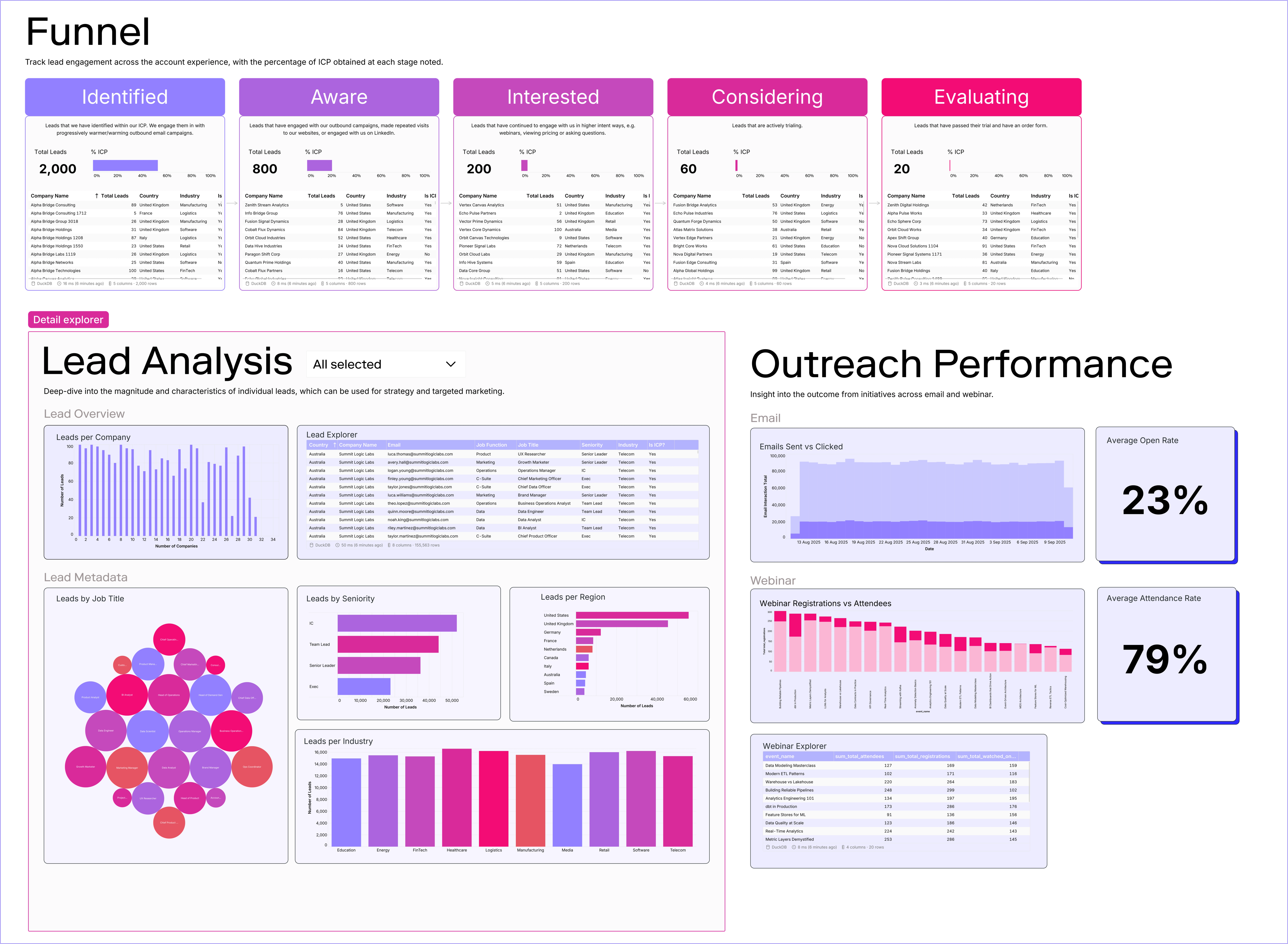Your "Target Account" Has 47 Touchpoints. Is Anyone Actually Buying?
Your demand gen team just presented at the pipeline review. They're hitting all the accounts on the target list. Email sequences running. LinkedIn ads targeted. Webinar invites sent. Three contacts at Enterprise Account X have engaged.
Your VP of Sales asks: "Great. Where are they in the buying process?"
Silence.
Someone checks HubSpot. "Two leads are MQLs. One attended a webinar."
Someone else checks Salesforce. "There's an opportunity, stage is 'Discovering Needs.'"
Someone checks the webinar platform. "Three people from that account registered, two attended."
Ten minutes of data archaeology later, nobody can actually answer the question. Are they aware of your solution? Actively interested? Considering alternatives? Actually evaluating a purchase?
You're running account-based marketing. You just can't see accounts.
The Lead-Based ABM Paradox
Here's the problem with most ABM programs: your systems are built for leads, not accounts.
HubSpot tracks individual contacts. Marketo scores individual leads. Your marketing automation sends emails to people, not companies. You're executing an account-based strategy with lead-based tools.
So what actually happens?
Marketing sees engagement scattered across leads. Contact A opened three emails. Contact B attended a webinar. Contact C visited the pricing page. But are these three people coordinating? Are they the buying committee? Or three random employees who vaguely know you exist?
Sales sees opportunities, not journeys. Salesforce shows "Opportunity Created" but not "how did we get here?" Did this account progress naturally through awareness and interest, or did one champion force a meeting while the rest of the buying team is cold?
Nobody sees account progression. You're running campaigns. Tracking touches. Measuring engagement. But you can't answer: "Which stage is this account actually in? Are they identified but cold? Aware but not interested? Interested but stalled? Considering but not ready?"
Your ABM motion spans multiple tools—marketing automation for outbound sequences, LinkedIn for social engagement, webinar platforms for events, CRM for sales touches, 6sense or Demandbase for intent data. Each tool shows you a piece. None show you the account.
So you're making decisions blind:
- Continuing to nurture accounts that are already evaluating (wasting touches)
- Pushing for meetings with accounts that aren't even aware yet (killing opportunities)
- Celebrating "engagement" that's one person clicking links while the buying committee ignores you
- Missing multi-threaded progress because you can't see three contacts at different stages rolling up to one account view
Same ABM strategy, completely fragmented execution.
What If You Could See Account Progression, Not Just Lead Activity?
Count's ABX funnel shows individual lead engagement rolling up to account-level view—through actual buying stages.
The funnel: Identified → Aware → Interested → Considering → Evaluating.
Identified: Accounts in your ICP. You're engaging them with outbound campaigns, but they're still cold.
Aware: Leads at the account have engaged. Opened outbound emails. Made repeated website visits. Engaged on LinkedIn. Someone knows you exist.
Interested: Higher intent. Webinar attendance. Pricing page views. Asking questions. Someone is actively exploring.
Considering: Trial started. Demo completed. Multiple stakeholders involved. Real buying motion.
Evaluating: Past the trial. Order form stage. Commercial conversation happening.
Each account sits in a stage. Each lead's activities—email engagement, webinar attendance, website behavior—contribute to moving the account forward. You can drill into key motions (outbound email sequences, webinar registrations) to see which activities actually drive progression.
Which is a fancy way of saying: you finally see accounts, not just scattered lead activities.
Your demand gen lead opens the canvas and sees: Enterprise Account X has three engaged contacts, sitting in "Interested" stage. Two attended the webinar, one visited pricing three times, all responding to outbound sequences. Multi-threaded. Progressing. Ready for sales.
Your sales rep sees the same canvas and knows: don't cold-call this account—they're already interested. The buying committee is engaged. Time for a demo, not another nurture sequence.
Your CMO sees 47 target accounts. 12 are still "Identified" (cold, need more touches). 18 are "Aware" (engaging but not converting—content gap?). 11 are "Interested" (prime for sales handoff). 4 are "Considering." 2 are "Evaluating."
One view. Singular visibility. Actual account progression instead of scattered lead metrics.
Done.
From Lead Chaos to Account Clarity
Here's what changes when you see accounts, not just leads:
Marketing and sales align. Everyone sees the same account stage. No more "we sent 50 emails" vs "they're not ready." The data shows where accounts actually are.
You spot multi-threaded engagement. Three contacts engaging? That's momentum. One contact clicking everything while the rest ignore you? That's single-threaded risk.
You understand what works. Which activities move accounts from Aware to Interested? From Interested to Considering? Stop guessing. See the patterns.
The reality is: enterprise buying is an account-level decision. But your tools are lead-level systems. HubSpot, Marketo, Salesforce—they're all built for individual contacts, not buying committees.
Build your ABX funnel once. Connect your scattered engagement data—email, webinars, CRM, website. Roll individual lead activities up to account progression. And finally run account-based marketing with an actual account view.
